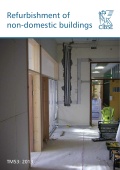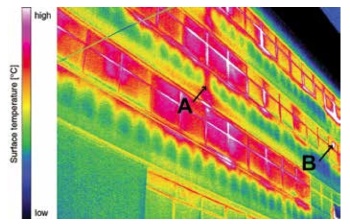Refurbishment as a vital energy-saving prospect

Keeping up with legislation and the need to reduce energy demand and carbon emissions demands major improvements to existing buildings. Mike Goodwin sets the background for CIBSE’s new TM53.
With many news items and Government updates focusing on new zero-carbon buildings as a remedy for cutting carbon emissions, learning that new builds only count for about 1% of each year’s building stock helps put the importance of refurbishments into perspective. The case for refurbishment has to be made on an individual basis for each and every project, and the drivers that exist are many and varied. TM53 ‘Refurbishment of non-domestic buildings’ aims to assist in understanding the buildings and existing systems and the production of a common strategy for the analysis of options and selection of appropriate solutions.
There is a need to reduce energy demand by measuring, monitoring and managing energy use in non-domestic buildings — in addition to introducing more energy efficient materials. By measuring energy use we can discover where it is being used and how it is being wasted, which is essential if we hope to find solutions.
 |
| Expert guidance — CIBSE’s TM53 on refurbishing non-domestic buildings runs to 96 pages. |
Succeeding in saving energy this way is recognised as the biggest opportunity for the United Kingdom to reduce its carbon emissions in the built environment. It is not only important to reduce energy use for the UK’s security of energy supply and our national carbon emissions targets, but we must also adhere to our share of the EU’s 20-20-20 targets. These are a 20% reduction in carbon emissions from 1990 level, increasing energy generation from renewable sources by 20% and a 20% improvement in the EU’s energy efficiency.
In order to attempt to help meet the EU’s 20-20-20 targets and to successfully complete a refurbishment project, an appreciation of the existing building and its services needs to be undertaken, such that the limitations and possibilities can be assessed. It is probable that a refurbishment project will combine improvements to the building envelope as well as to the building services. Evaluating all of these elements enables the investment to deliver across all areas of performance, comfort, legislative compliance and carbon emissions reduction.
Special considerations need to be made when replacing services in listed and heavily occupied buildings. For example, with Dunwoody LLP, we needed to refurbish the endoscopy facility and training rooms at The Royal Wolverhampton NHS Trust Hospital. Here we needed to make improvements to the whole facility to meet current requirements and standards whilst enabling other rooms to change usage. During the whole refurbishment the facility needed to be kept open, clean and safe to the public.
In the case of a leading retail store covering 7000 m2, the entire fire and smoke-ventilation strategy needed to be revised in addition to refurbishing the store and ensuring customer safety.
An important consideration is whether to install clean-energy systems where possible to reduce emissions and energy demand from the grid. A combined-heat-and-power (CHP) system could be installed, if loads are appropriate. Heat pumps using the ground, air or water as an energy source can provide heating and cooling. Air-source heat pumps are particularly interesting due to the relative ease of installation. The building’s soundproofing and building fabric also needs to be considered for occupant comfort as there could be disturbance from fan noise from the heat pump. Heat pumps can also help to reduce the building’s calculated CO2 emissions.
 |
| Thermography can help asses the performance of the building envelope. This early-morning shot of a 1960s office building from TM53 highlights a thermal bridge (A) and air leakage (B). |
With a growing population, energy use and rising temperatures, overheating of buildings and the atmosphere can create urban heat islands and contribute to climate change. This also needs to be considered when refurbishing buildings as, perhaps, ventilation and building materials can be improved to mitigate these effects. More guidance on these subjects is offered in CIBSE TM52: ‘The limits of thermal comfort: avoiding overheating in European buildings’ and ‘TM49: Summertime design guidance for London’.
Lighting must not be forgotten with regards to occupant comfort and energy use within a refurbishment. Controls for the lights such as timers and sensors can also contribute significant energy savings to complement the switch to LEDs or the promotion of natural light.
Refurbishments are splendid opportunities to save energy, improve marketability or income and to improve occupant comfort — but it is vital to consider all relevant factors when working on projects. Post-occupancy evaluations are also vital to learn how the project is working in practice, and this is valuable information to impart on future projects. Ensure there are handover notes and don’t be tempted to cut corners. Sharing these findings and, if available, data through CarbonBuzz can help the whole construction industry.
Mike Goodwin was chair of the CIBSE TM53 steering group.







